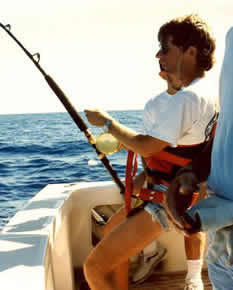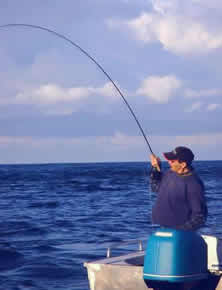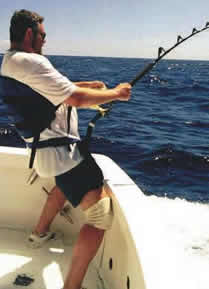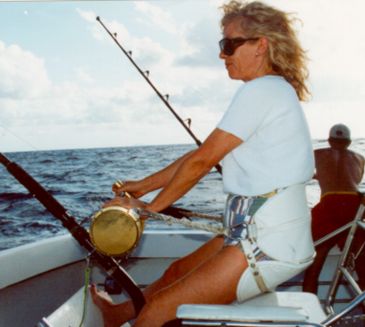05: Rods
Between The Lines - Chapter 02: The Gear
What a rod is and what it’s supposed to do is rarely asked when it comes to trolling skirted lures even though it is certainly one of the most important of all the angler’s tools. For the type of angling being discussed here, trolling lures and fighting relatively large powerful fish, the rod can make it a very pleasurable or painful experience.
The rod should have enough power to fight a fish effectively on the respective line class, but be soft enough for an angler to control. Rods are a lever, with the fulcrum at where you hold the rod. Even the shortest rods that conform to the angling rules put more pressure on the angler than the fish. As with the reel and line, rods vary according to the line class they are used with many factors coming into play.
The first is that a rod has to be capable of setting the hook. This is a balancing act between the line class i.e. drag setting, spool inertia, line stretch, thickness and sharpness of the hook and the “punch” of the rod. The more the system “cushions” the setting of the hook the harder it is to get the hook securely into what is often bone. Getting the hook in is an important part of the rod's job.
Once the hook is in the rod's job is to aid in controlling and fighting the fish by flexing according to the drag used. This aspect is not very well understood. The least amount of pressure the rod should work under is 33%, but it should also be able to lift 200% of the line class used without folding all the way to the reel seat, as part of the setup used when game fishing is the use of a double line at the end of the mainline. The maximum length varies from 15 to 30 feet depending on line class. The ability for the angler to increase pressure on a fish as it gets closer is an important technique in angling that is often overlooked. This is only possible using a rod with enough power to cope with the increase of load.
As the line class increases it may not be practical to have a rod that will pull 200% as the fulcrum of the rod i.e. length and stiffness may be impractical for anglers with a normal physique to pull on. In reality, each angler has an optimum configuration according to the line class used, though with a good technique an anger with a light build can transfer a great deal of pressure through the gear.
The longer the rod above where the rod is held during a fight i.e. by holding the reel by harness lugs, the harder it is to apply pressure. The shorter the easier it is i.e. by holding the foregrip as high as possible.
The longer the rod below where it is held the easier it is to put pressure on. However, the setup should be comfortable and to a large extent varies according to the individual. Considerations should be made to ensure that a loaded rod can still clear motors, swim platforms and the side of the boat.
There are two main points where a great deal of pressure is applied to the rod. These are the reel seat and gimbals i.e. where the rod sits, both of which should be of a specific design and materials to cope.The choice of guides or rollers is a simple one. In the small video, you’ll see how long nylon lasts under load on a normal guide. In fact the lighter and thinner the line the more susceptible to friction it is. In reality, the lighter the line class, the more necessary are roller guides. Rollers, like everything else we use, should be of high quality. The rollers should be tight against their frames and of appropriate size to the rod and line classes used. Tip rollers should be oversized to give less of an angle on the line.
Due to the strains involved and their specific use, there are many rod configurations, although we’ll break them down into three main configurations

Stand-up Straight Butt
These rods are used for stand up fishing in lines classes 50lb and less. Most
anglers can apply the necessary force for the duration of most fights on these line classes on these rods. The length can vary considerably from 8’ down to 5’. The longer the rod the more line can be recovered in a single pump and by holding the rod high as in many other forms of light tackle sports fishing more line can be kept out of the water. Unfortunately, the longer the rod the more pressure is placed on the angler.
The shorter the rod the easier it is to transfer pressure to fish which is also certainly desirable. As a result, heavier line class stand-up rods are generally shorter than those used for lighter line class.
With the use of gimbal rod belts and harness weight of the outfit is not a major factor. Although for some angling tactics the ability to use the rod without these aids is a great advantage in controlling the fish.
 |
 |
 |
| Stand-up Straight Butt | Long Rod | Stand-up Bent Butt |
Stand-up Bent Butt
These are very short rods with a small bent butt designed to give the angler maximum effective leverage on large fish. These are primarily 80lb rods with 50lb being quite common. There are some 130’s around but even the pressures exerted are far too much for guys with a normal physique and condition to cope with.
Short bent butt rods by nature of their short length and configuration are hard to pump line quickly. These are really rods for dealing with large fish in a protracted fight. With the right technique and fighting harness and gimbal, very big fish on stand up tackle are quite feasible.
These rods are useful on boats without game chairs or for anglers who travel and do not want to carry large bent butt outfits in their travels.
Bent Butt Chair
These are the big guns of "heavy tackle big game fishing". These rods are designed to use out of a fighting chair. The combination of these allows the angler to use their full weight to fight fish on heavy lines usually 80lb and 130lb.
All the components are very heavy duty. The weight of the outfit is not a major factor as the chair supports the weight. Under load moving the rod around the transom is impractical, so the rods are designed to be long and stiff to ideally reach over the corners of the boat so that lines clear the transom when the rod is loaded on a fish that is straight under the boat.
There are several techniques that we’ll go through at a later date that enable anglers with a small build to effectively use this heavy tackle, although it is quite awkward for anglers with a heavy build to use light tackle.






